GEEKOM Mini IT13 Review: Core i9-13900H in a 4x4 Package
by Ganesh T S on October 16, 2023 8:00 AM ESTWorkstation Performance - SPECworkstation 3.1
SFF PCs traditionally do not lend themselves to workstation duties. However, a recent trend towards miniaturized workstations has been observed. While systems in the GEEKOM Mini IT13's form-factor are still not capable enough to become workstations, the rapid performance improvements over the years has encouraged us to benchmark some of these UCFF / SFF systems for content creation workloads and professional applications. Towards this, we processed the SPECworkstation 3.1 benchmark from SPEC.
The SPECworkstation 3.1 benchmark measures workstation performance based on a number of professional applications. It includes more than 140 tests based on 30 different workloads that exercise the CPU, graphics, I/O and memory hierarchy. These workloads fall into different categories.
- Media and Entertainment (3D animation, rendering)
- Product Development (CAD/CAM/CAE)
- Life Sciences (medical, molecular)
- Financial Services
- Energy (oil and gas)
- General Operations
- GPU Compute
Individual scores are generated for each test and a composite score for each category is calculated based on a reference machine (HP Z240 tower workstation using an Intel E3-1240 v5 CPU, an AMD Radeon Pro WX3100 GPU, 16GB of DDR4-2133, and a SanDisk 512GB SSD). Official benchmark results generated automatically by the benchmark itself are linked in the table below for the systems being compared.
| SPECworkstation 3.1 Official Results (2K) | |
| GEEKOM Mini IT13 | Run Summary |
| GEEKOM AS 6 (ASUS PN53) | Run Summary |
| Intel NUC12WSKi7 (Wall Street Canyon) | Run Summary |
| ASRock NUC BOX-1360P-D5 (Performance) | Run Summary |
| ASRock 4X4 BOX-7735U (Performance) | Run Summary |
| Beelink GTR7 | Run Summary |
| ASRock NUCS BOX-1360P-D4 | Run Summary |
| Intel NUC11PAQi7 (Panther Canyon) | Run Summary |
| Intel NUC13ANKi7 (Arena Canyon) | Run Summary |
Details of the tests in each category, as well as an overall comparison of the systems on a per-category basis are presented below.
Media and Entertainment
The Media and Entertainment category comprises of workloads from five distinct applications:
- The Blender workload measures system performance for content creation using the open-source Blender application. Tests include rendering of scenes of varying complexity using the OpenGL and ray-tracing renderers.
- The Handbrake workload uses the open-source Handbrake application to transcode a 4K H.264 file into a H.265 file at 4K and 2K resolutions using the CPU capabilities alone.
- The LuxRender workload benchmarks the LuxCore physically based renderer using LuxMark.
- The Maya workload uses the SPECviewperf 13 maya-05 viewset to replay traces generated using the Autodesk Maya 2017 application for 3D animation.
- The 3ds Max workload uses the SPECviewperf 13 3dsmax-06 viewset to replay traces generated by Autodesk's 3ds Max 2016 using the default Nitrous DX11 driver. The workload represents system usage for 3D modeling tasks.
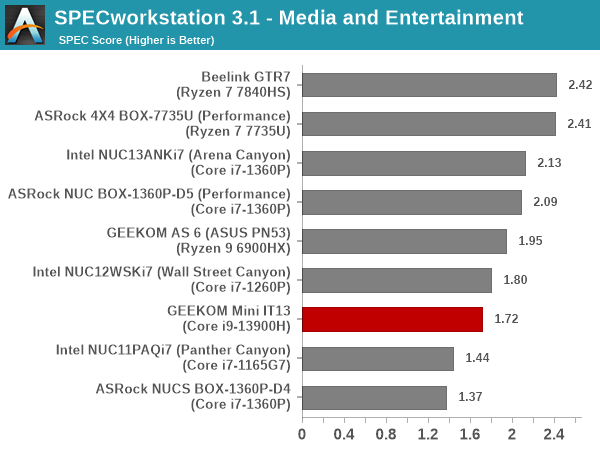
Product Development
The Product Development category comprises of eight distinct workloads:
- The Rodinia (CFD) workload benchmarks a computational fluid dynamics (CFD) algorithm.
- The WPCcfd workload benchmarks another CFD algorithm involving combustion and turbulence modeling.
- The CalculiX workload uses the Calculix finite-element analysis program to model a jet engine turbine's internal temperature.
- The Catia workload uses the catia-05 viewset from SPECviewperf 13 to replay traces generated by Dassault Systemes' CATIA V6 R2012 3D CAD application.
- The Creo workload uses the creo-02 viewset from SPECviewperf 13 to replay traces generated by PTC's Creo, a 3D CAD application.
- The NX workload uses the snx-03 viewset from SPECviewperf 13 to replay traces generated by the Siemens PLM NX 8.0 CAD/CAM/CAE application.
- The Solidworks workload uses the sw-04 viewset from SPECviewperf 13 to replay traces generated by Dassault Systemes' SolidWorks 2013 SP1 CAD/CAE application.
- The Showcase workload uses the showcase-02 viewset from SPECviewperf 13 to replay traces from Autodesk's Showcase 2013 3D visualization and presentation application
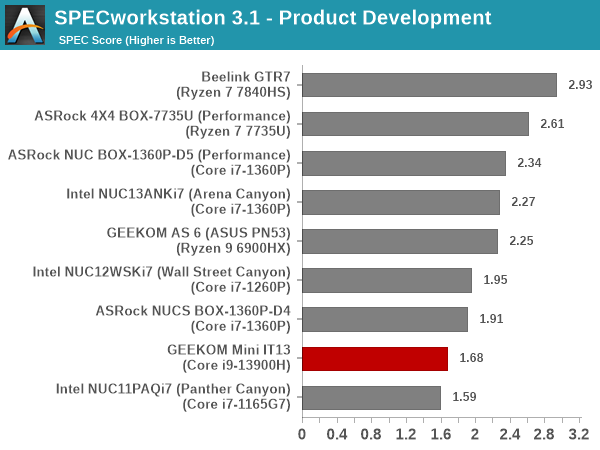
Life Sciences
The Life Sciences category comprises of four distinct test sets:
- The LAMMPS set comprises of five tests simulating different molecular properties using the LAMMPS molecular dynamics simulator.
- The NAMD set comprises of three tests simulating different molecular interactions.
- The Rodinia (Life Sciences) set comprises of four tests - the Heartwall medical imaging algorithm, the Lavamd algorithm for calculation of particle potential and relocation in a 3D space due to mutual forces, the Hotspot algorithm to estimate processor temperature with thermal simulations, and the SRAD anisotropic diffusion algorithm for denoising.
- The Medical workload uses the medical-02 viewset from SPECviewperf 13 to determine system performance for the Tuvok rendering core in the ImageVis3D volume visualization program.
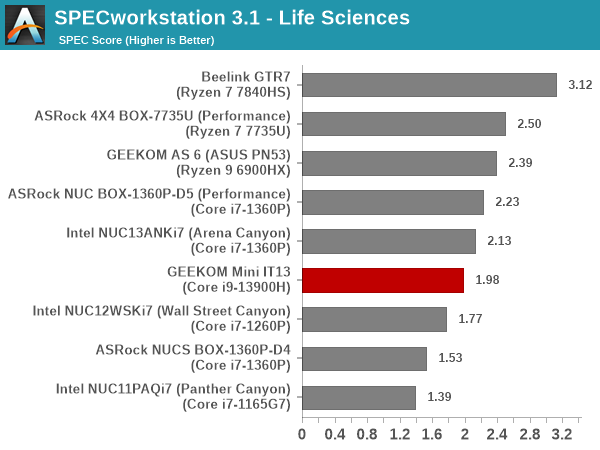
Financial Services
The Financial Services workload set benchmarks the system for three popular algorithms used in the financial services industry - the Monte Carlo probability simulation for risk assessment and forecast modeling, the Black-Scholes pricing model, and the Binomial Options pricing model.
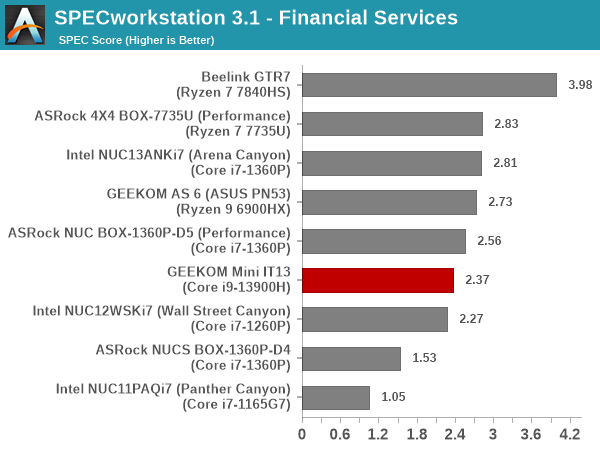
Energy
The Energy category comprises of workloads simulating various algorithms used in the oil and gas industry:
- The FFTW workload computes discrete Fourier transforms of large matrices.
- The Convolution workload computes the convolution of a random 100x100 filter on a 400 megapixel image.
- The SRMP workload processes the Surface-Related Multiples Prediction algorithm used in seismic data processing.
- The Kirchhoff Migration workload processes an algorithm to calculate the back propogation of a seismic wavefield.
- The Poisson workload takes advantage of the OpenMP multi-processing framework to solve the Poisson's equation.
- The Energy workload uses the energy-02 viewset from SPECviewperf 13 to determine system performance for the open-source OPendTec seismic visualization application.
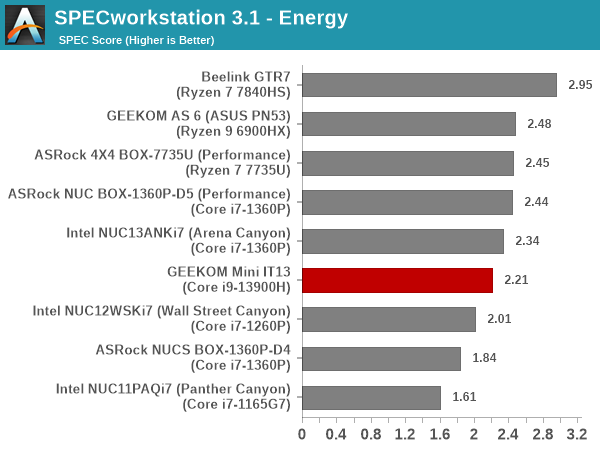
General Operations
In the General Options category, the focus is on workloads from widely used applications in the workstation market:
- The 7zip workload represents compression and decompression operations using the open-source 7zip file archiver program.
- The Python workload benchmarks math operations using the numpy and scipy libraries along with other Python features.
- The Octave workload performs math operations using the Octave programming language used in scientific computing.
- The Storage workload evaluates the performance of the underlying storage device using transaction traces from multiple workstation applications.

GPU Compute
In the GPU Compute category, the focus is on workloads taking advantage of the GPU compute capabilities using either OpenCL or CUDA, as applicable:
- The LuxRender benchmark is the same as the one seen in the media and entertainment category.
- The Caffe benchmark measures the performance of the Caffe deep-learning framework.
- The Folding@Home benchmark measures the performance of the system for distributed computing workloads focused on tasks such as protein folding and drug design.
We only process the OpenCL variants of the benchmark, as the CUDA version doesn't process correctly with default driver installs. This workload is a weak point for Intel's iGPUs, as they can't complete some of the components successfully.
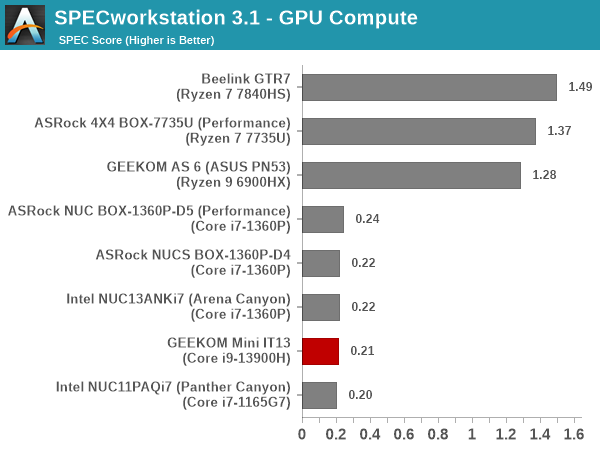
Workloads processed on workstations are long-running tasks that don't benefit in any meaningful way from higher PL1 numbers. UCFF systems find it difficult to sustain these higher package power numbers for a long enough time to influence the performance in workstation benchmarks. As a result, the relative performance of the GEEKOM Mini IT13 in SPECworkstation v3.1 is dictated by its sustained package power limit of 35W. The presence of two additional high-performance cores over the RPL-P systems lends it some advantage in a few multi-threaded workloads, but these cores are slowed down compared to the RPL-P due to the latter being configured for a 40W PL1 in most of the compared systems. The net result is that the GEEKOM Mini IT13 makes its mark in the bottom half of the pack across almost all workload components.










9 Comments
View All Comments
meacupla - Monday, October 16, 2023 - link
DDR4 in a i9-13900H is certainly a... choice.Does it at least support overclocked XMP profiles? Like 1.35V DDR4-3200 CAS16, or 1.35V DDR4-4000 CAS19.
The 2.5in drive bay is an crazy choice, considering it thermally throttles.
2242 SATA SSD? Really? It doesn't even have a second 2280 NVMe slot?
I guess on the plus side, someone will tinker and figure out how to slap on a cooler that can handle the i9.
eriri-el - Monday, October 16, 2023 - link
xmp is not designed to load by default. in that case there is no way xmp is supported at all.just watch the video too see how barebones that bios is.
meacupla - Monday, October 16, 2023 - link
oh man, that mini-PC is pure sadness. Can't even run fast DDR4 SODIMM, on top of being hamstrung by poor cooling.MishaalKhalid - Wednesday, October 25, 2023 - link
Featuring Core i9-13900H, this 4x4 package delivers outstanding performance. Ideal for <a href="https://edubirdie.ae/">essay writers in Dubai</a>, it ensures swift, efficient work in a compact design.Samus - Tuesday, October 17, 2023 - link
It's a good value all things considered but I can't help but think what a waste of silicon this is.PeachNCream - Tuesday, October 17, 2023 - link
So basically it should be using a far more power efficient CPU or a more substantial cooling solution or both. And it's limited to 16GB of DDR4. That's like Acer levels of corner cutting.ganeshts - Tuesday, October 17, 2023 - link
The CPU is good, just that it needs to be configured for a package power of at least 40W.As for memory support, I am sure nothing prevents installation of 2x 32GB DDR4-3200 SODIMMs. It is just that the pre-configured system available from GEEKOM comes with 2x 16GB DDR4-3200 SODIMMs.
eastcoast_pete - Wednesday, October 18, 2023 - link
Agree. This unit would benefit greatly from better airflow, similar to what the Beelink GTR/GTR Pro now has. As it is, not really that convincing, and there are better mini PCs for the money.desierto - Monday, October 23, 2023 - link
pues lo compre hace unos días, di premiera día tengo problema con la problema que cada 15-30 minutos la pantalla del monitor se pone negra por un segundo, y este me molesta y me preocupa, que no puedo resolverlo, he probado todos los consejos de internet y no me ayudo nada. El Atención de clientes de GEEKOM es una mierda en todo sentido. La verdad que me arrepiento mucho en conseguirlo. Mejor pagaría un poco mas y compraría de una marca seria y profesional como seria Lenovo, Asus o Dell.